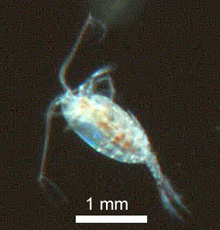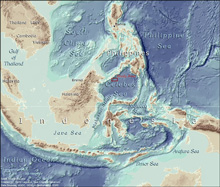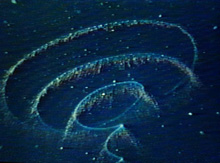Lying just north of the equator, the Celebes Sea is the center of the most biologically diverse area of the world’s ocean. Our expedition will begin in the Port of Manila (top center) and take us south through the Sulu Sea to our study site, southeast of the Sulu Archipelago, where the bottom falls off abruptly to the sea floor thousands of meters below. In comparison to the size of the Celebes Sea (the 500 kilometer scale bar on the map would easily lie inside the basin), our study area is relatively small, but we hope that our discoveries will stimulate more extensive exploration and research in these fascinating ecosystems. Click image for larger view and image credit.
Mission Plan
Larry Madin
Chief Scientist – Exploring the Inner Space of the Celebes Sea 2007
Senior Scientist and Acting Director of Research
Woods Hole Oceanographic Institution
The Midwater Environment
We all know that the ocean covers 70% of our planet, but we rarely think about how deep most of that water is. The ocean below the depth of sunlight — the midwater — is by far the largest volume of living space on Earth. This environment is dramatically different from any other: dark, cold, weightless, timeless, and virtually infinite in any direction. The animals living here have evolved under conditions unlike anything we see on land. These often bizarre-looking fishes, crustaceans, squid, and jellyfish are important food-web links between the many organisms living in the productive shallow layer and the scarcer animals that live far below the midwater realm. But midwater animals remain among the least well known creatures on Earth.
Earth’s Richest Marine Diversity
The Southeast Asian nations of Philippines, Malaysia, and Indonesia occupy one of the richest biological environments on Earth. Sometimes called the “Coral Triangle,” this region of islands and ocean basins is considered a "hotspot" of biodiversity, both on land and in shallow marine environments. Until now, most of our knowledge of marine biodiversity here has been from shallow water environments — the deep sea is almost entirely unexplored. The goal of Exploring the Inner Space of the Celebes Sea 2007 is to learn more about this center of shallow-water biodiversity by studying the fauna in the midwater realm and making extensive vertical surveys of the water column. Our mission will explore one of the most intriguing parts of the deep sea — the deep basin of the Celebes Sea, south of the island of Mindanao in the Philippines.
The Celebes Sea is bordered by shallow ocean regions, which greatly limits the exchange of deep-water animals with other deep-water areas in the sea. During past times of lower sea level, the deep basins were completely isolated by dry land, and they may have developed highly endemic faunas (animals found exclusively in that area). We hope to learn whether diverse, endemic, and undiscovered species will be found within the Celebes basins. Recently two "living fossils," a coelacanth fish and a primitive shrimp, were found in the Celebes Sea, and more rare or unknown species may be found in the course of our explorations.
Captured on video in midwater, this siphonophore is coiled into its fishing posture, with nematocyst-loaded (stinging) tentacles dangling to entangle unwary prey. This behavior was unknown before researchers could observe such animals — undisturbed and in their own realm — via manned submersibles and by remotely operated vehicles equipped with cameras. Modern technology has vastly increased our understanding of life in the depths of the ocean, but still this largest living space on Earth is mostly unexplored. Click image for larger view and image credit.
Tools and Goals
Our exploration will use a combination of tools to penetrate and sample the depths. A remotely operated vehicle (ROV) will take photographs and video as well as collect specimens down to 3,000 meters. Additional samples will be collected with a midwater trawl net, or photographed with baited cameras. Fragile animals in surface waters will be filmed and collected by scuba divers, with additional samples of zooplankton taken with plankton nets.
Following the expedition, investigators in the U.S. and Philippines will analyze the biodiversity of the sampled fauna, comparing the findings with other ocean regions. Our results will be communicated through scientific papers, Web sites, and magazine articles. All of our data from this expedition will make a significant contribution to the Census of Marine Life, a global inventory of life in the world’s oceans.





























